Climate-Adaptive Design Strategies of Sports Stadia in a Hot Summer and Cold Winter Zone: A Case Study of Nanjing
Abstract
:1. Introduction
2. Climate-Adaptive Design Principles and Key Points
2.1. Design Principles for the Climatic Adaptation of Buildings in Hot Summer and Cold Winter Zones
- Actively prevent external adverse climatic factors.
- Balance the demand of buildings in different climates.
2.2. Key Points for the Climatic Design of Sports Stadia in Hot Summer and Cold Winter Zones
3. Methods
3.1. Overview of the Study Area
3.2. Architectural Examples and Abstract Models
3.2.1. Selection of Architectural Examples
3.2.2. Construction of Abstract Models
3.3. Tools for Simulation Experiments
3.3.1. Software Introduction
3.3.2. Basic Meteorological Parameter Setting
4. Result
4.1. Simulation Analysis of Building Layout
4.1.1. Construction of Layout Abstract Model
4.1.2. Simulation Condition Setting of Layout Abstract Model
4.1.3. Simulation Results of Layout Abstract Model
- (1)
- Orientation and wind speed distribution in a triangle layout
- (2)
- Orientation and wind speed distribution in one-line layout.
4.2. Simulation Analysis of Building Shape
4.2.1. Construction of Shape Abstract Model
4.2.2. Simulation Condition Setting of Shape Abstract Model
4.2.3. Simulation Results of Shape Abstract Model
4.3. Simulation Analysis of Building Structure
4.3.1. Construction of Structure Abstract Model
4.3.2. Simulation Condition Setting of Structure Abstract Model
4.3.3. Simulation Results of Structure Abstract Model
5. Discussion
6. Conclusions
Author Contributions
Funding
Data Availability Statement
Conflicts of Interest
References
- Zhao, X.; Ma, X.; Chen, B.; Shang, Y.; Song, M. Challenges toward carbon neutrality in China: Strategies and countermeasures. Resour. Conserv. Recycl. 2022, 176, 105959. [Google Scholar] [CrossRef]
- Bazazzadeh, H.; Nadolny, A.; Safaei, S.S.H. Climate Change and Building Energy Consumption: A Review of the Impact of Weather Parameters Influenced by Climate Change on Household Heating and Cooling Demands of Buildings. Eur. J. Sustain. Dev. 2021, 10, 1–12. [Google Scholar] [CrossRef]
- Liu, X.; Liu, X.; Luo, X.; Wang, M.; Fu, H.; Wang, B.; Sun, Y.; Hu, W. Analysis on the influencing mechanism of informational policy instrument on adopting energy consumption monitoring technology in public buildings. Energy Effic. 2020, 13, 1485–1503. [Google Scholar] [CrossRef]
- Wang, L.; Huang, Q.; Zhang, Q.; Xu, H.; Yuen, R.K. Role of atrium geometry in building energy consumption: The case of a fully air-conditioned enclosed atrium in cold climates, China. Energy Build. 2017, 151, 228–241. [Google Scholar] [CrossRef]
- Xu, P.; Huang, J.; Shen, P.; Ma, X.; Gao, X.; Xu, Q.; Jiang, H.; Xiang, Y. Commercial building energy use in six cities in Southern China. Energy Policy 2013, 53, 76–89. [Google Scholar] [CrossRef]
- Yuce, B.; Li, H.; Rezgui, Y.; Petri, I.; Jayan, B.; Yang, C. Utilizing artificial neural network to predict energy consumption and thermal comfort level: An indoor swimming pool case study. Energy Build. 2014, 80, 45–56. [Google Scholar] [CrossRef]
- Wang, K.; Wang, X. Providing Sports Venues on Mainland China: Implications for Promoting Leisure-Time Physical Activity and National Fitness Policies. Int. J. Environ. Res. Public Health 2020, 17, 5136. [Google Scholar] [CrossRef] [PubMed]
- Vogeler, C.S.; van den Dool, A.; Chen, M. Programmatic action in Chinese health policy—The making and design of “Healthy China 2030”. Rev. Policy Res. 2023, 40, 534–552. [Google Scholar] [CrossRef]
- Stagrum, A.E.; Andenæs, E.; Kvande, T.; Lohne, J. Climate Change Adaptation Measures for Buildings—A Scoping Review. Sustainability 2020, 12, 1721–1738. [Google Scholar] [CrossRef]
- Oropeza-Perez, I.; Østergaard, P.A. Potential of natural ventilation in temperate countries—A case study of Denmark. Appl. Energy 2014, 114, 520–530. [Google Scholar] [CrossRef]
- Cerra, J. Inland Adaptation: Developing a Studio Model for Climate-adaptive Design as a Framework for Design Practice. Landsc. J. 2016, 35, 37–55. [Google Scholar] [CrossRef]
- Liu, Y.; Wang, J.; Ren, J.; Xiao, Q.; Zhao, J. A Preliminary Study on the Climate Adaptive Design of Green Rural Houses in west China. Procedia Eng. 2017, 180, 735–740. [Google Scholar] [CrossRef]
- Shen, J.; Copertaro, B.; Sangelantoni, L.; Zhang, X.; Suo, H.; Guan, X. An early-stage analysis of climate-adaptive designs for multi-family buildings under future climate scenario: Case studies in Rome, Italy and Stockholm, Sweden. J. Build. Eng. 2020, 27, 100972. [Google Scholar] [CrossRef]
- Liu, L.; Liu, J.; Jin, L.; Liu, L.; Gao, Y.; Pan, X. Climate-conscious spatial morphology optimization strategy using a method combining local climate zone parameterization concept and urban canopy layer model. Build. Environ. 2020, 185, 107301. [Google Scholar] [CrossRef]
- Teshnehdel, S.; Akbari, H.; Di Giuseppe, E.; Brown, R.D. Effect of tree cover and tree species on microclimate and pedestrian comfort in a residential district in Iran. Build. Environ. 2020, 178, 106899. [Google Scholar] [CrossRef]
- Aboulnaga, M.; Alwan, A.; Elsharouny, M.R. Climate Change Adaptation: Assessment and Simulation for Hot-Arid Urban Settlements—The Case Study of the Asmarat Housing Project in Cairo, Egypt. In Sustainable Building for a Cleaner Environment: Selected Papers from the World Renewable Energy Network’s Med Green Forum 2017; Sayigh, A., Ed.; Springer International Publishing: Cham, Switzerland, 2019; pp. 437–449. [Google Scholar]
- Mughal, M.O.; Li, X.-X.; Norford, L.K. Urban heat island mitigation in Singapore: Evaluation using WRF/multilayer urban canopy model and local climate zones. Urban Clim. 2020, 34, 100714. [Google Scholar] [CrossRef]
- Mabon, L.; Kondo, K.; Kanekiyo, H.; Hayabuchi, Y.; Yamaguchi, A. Fukuoka: Adapting to climate change through urban green space and the built environment? Cities 2019, 93, 273–285. [Google Scholar] [CrossRef]
- Mauree, D.; Naboni, E.; Coccolo, S.; Perera, A.; Nik, V.M.; Scartezzini, J.-L. A review of assessment methods for the urban environment and its energy sustainability to guarantee climate adaptation of future cities. Renew. Sustain. Energy Rev. 2019, 112, 733–746. [Google Scholar] [CrossRef]
- Kim, H.; Clayton, M.J. A multi-objective optimization approach for climate-adaptive building envelope design using parametric behavior maps. Build. Environ. 2020, 185, 107292. [Google Scholar] [CrossRef]
- Yang, L.; Fu, R.; He, W.; He, Q.; Liu, Y. Adaptive thermal comfort and climate responsive building design strategies in dry-hot and dry-cold areas: Case study in Turpan, China. Energy Build. 2019, 209, 109678. [Google Scholar] [CrossRef]
- Zhou, Y.; Zheng, S.; Liu, Z.; Wen, T.; Ding, Z.; Yan, J.; Zhang, G. Passive and active phase change materials integrated building energy systems with advanced machine-learning based climate-adaptive designs, intelligent operations, uncertainty-based analysis and optimisations: A state-of-the-art review. Renew. Sustain. Energy Rev. 2020, 130, 109889. [Google Scholar] [CrossRef]
- Wilson, K.L.; Tittensor, D.P.; Worm, B.; Lotze, H.K. Incorporating climate change adaptation into marine protected area planning. Glob. Chang. Biol. 2020, 26, 3251–3267. [Google Scholar] [CrossRef] [PubMed]
- Juan, X.; Ziliang, L.; Weijun, G.; Mengsheng, Y.; Menglong, S. The comparative study on the climate adaptability based on indoor physical environment of traditional dwelling in Qinba mountainous areas, China. Energy Build. 2019, 197, 140–155. [Google Scholar] [CrossRef]
- Izadyar, N.; Miller, W.; Rismanchi, B.; Garcia-Hansen, V. Impacts of façade openings’ geometry on natural ventilation and occupants’ perception: A review. Build. Environ. 2020, 170, 106613. [Google Scholar] [CrossRef]
- Ghosh, A.; Norton, B. Advances in switchable and highly insulating autonomous (self-powered) glazing systems for adaptive low energy buildings. Renew. Energy 2018, 126, 1003–1031. [Google Scholar] [CrossRef]
- Qi, J.; Wei, C. Performance evaluation of climate-adaptive natural ventilation design: A case study of semi-open public cultural building. Indoor Built Environ. 2020, 30, 1714–1724. [Google Scholar] [CrossRef]
- Li, Y.; Tong, Z. Development of real-time adaptive model-free extremum seeking control for CFD-simulated thermal environment. Sustain. Cities Soc. 2021, 74, 103166. [Google Scholar] [CrossRef]
- Javad, K.; Navid, G. Thermal comfort investigation of stratified indoor environment in displacement ventilation: Climate-adaptive building with smart windows. Sustain. Cities Soc. 2019, 46, 101354. [Google Scholar] [CrossRef]
- Hu, J.; Yu, X. Adaptive building roof by coupling thermochromic material and phase change material: Energy performance under different climate conditions. Constr. Build. Mater. 2020, 262, 120481. [Google Scholar] [CrossRef]
- Gaspari, J.; Emanuele, N.; Caterina, P.; Adele, R. A Study on the Impact of Climate Adaptive Building Shells on Indoor Comfort. J. Facade Des. Eng. 2019, 7, 27–40. [Google Scholar] [CrossRef]
- Vasigh, B.; Shiri, T. Climatic Adaptation of the Dome Body Based on Solar Radiation Received; Case Study: The Domes of Shah Mosque, Sheikh Lotfollah Mosque, Al-Nabi Mosque of Qazvin and Jameh Mosque of Urmia. Arman. Archit. Urban Dev. 2021, 13, 211–225. [Google Scholar] [CrossRef]
- Sakiyama, N.; Carlo, J.; Frick, J.; Garrecht, H. Perspectives of naturally ventilated buildings: A review. Renew. Sustain. Energy Rev. 2020, 130, 109933. [Google Scholar] [CrossRef]
- Bensafi, M.; Ameur, H.; Kaid, N.; Hoseinzadeh, S.; Memon, S.; Garcia, D.A. Thermophysics Analysis of Office Buildings with a Temperature–Humidity Coupling Strategy Under Hot-Arid Climatic Conditions. Int. J. Thermophys. 2021, 42, 118. [Google Scholar] [CrossRef]
- Kuru, A.; Oldfield, P.; Bonser, S.; Fiorito, F. Performance prediction of biomimetic adaptive building skins: Integrating multifunctionality through a novel simulation framework. Sol. Energy 2021, 224, 253–270. [Google Scholar] [CrossRef]
- Fosas, D.; Coley, D.A.; Natarajan, S.; Herrera, M.; de Pando, M.F.; Ramallo-Gonzalez, A. Mitigation versus adaptation: Does insulating dwellings increase overheating risk? Build. Environ. 2018, 143, 740–759. [Google Scholar] [CrossRef]
- Xu, W. Environmental Performance Optimization Design of Marine Climate Adaptive Green Public Buildings. J. Coast. Res. 2020, 106, 342–346. [Google Scholar] [CrossRef]
- Xue, F.; Gou, Z.; Lau, S.S. Human Factors in Green Office Building Design: The Impact of Workplace Green Features on Health Perceptions in High-Rise High-Density Asian Cities. Sustainability 2016, 8, 1095. [Google Scholar] [CrossRef]
- Jing, Q.; Li, J.; Li, L.; Jia, M.; Zhou, Y.; Zhao, X. Passive design of green public buildings adapted to cold climate: A case study of China pavilion of the international horticultural exhibition 2019 Beijing China. IOP Conf. Ser. Earth Environ. Sci. 2021, 768, 012130. [Google Scholar] [CrossRef]
- Hong, Y.; Ezeh, C.; Deng, W.; Lu, J.; Ma, Y.; Jin, Y. Climate adaptation of design scheme for energy-conserving high-rise buildings—Comparative study of achieving building sustainability in different climate scenarios. Energy Rep. 2022, 8, 13735–13752. [Google Scholar] [CrossRef]
- Manni, M.; Nicolini, A. Multi-Objective Optimization Models to Design a Responsive Built Environment: A Synthetic Review. Energies 2022, 15, 486. [Google Scholar] [CrossRef]
- Upadhyay, A.K.; Yoshida, H.; Rijal, H.B. Climate Responsive Building Design in the Kathmandu Valley. J. Asian Archit. Build. Eng. 2006, 5, 169–176. [Google Scholar] [CrossRef]
- Huang, Z.; Cheng, B.; Gou, Z.; Zhang, F. Outdoor thermal comfort and adaptive behaviors in a university campus in China’s hot summer-cold winter climate region. Build. Environ. 2019, 165, 106414. [Google Scholar] [CrossRef]
- Guo, Y.; Bart, D. Optimization of Design Parameters for Office Buildings with Climatic Adaptability Based on Energy Demand and Thermal Comfort. Sustainability 2020, 12, 3540. [Google Scholar] [CrossRef]
- Lee, J.; Lee, K.S.; Lim, J. Passive Design Techniques Aplied to Green Buildings As An Aesthetic and Spatial Design Concept. J. Green Build. 2015, 10, 79–109. [Google Scholar] [CrossRef]
- Cheng, Z.; Lei, N.; Bu, Z.; Sun, H.; Li, B.; Lin, B. Investigations of indoor air quality for office buildings in different climate zones of China by subjective survey and field measurement. Build. Environ. 2022, 214, 108899. [Google Scholar] [CrossRef]
- Pan, L.; Xu, Q.; Nie, Y.; Qiu, T. Analysis of climate adaptive energy-saving technology approaches to residential building envelope in Shanghai. J. Build. Eng. 2018, 19, 266–272. [Google Scholar] [CrossRef]
- Wu, H.; Zhang, T. Multi-objective optimization of energy, visual, and thermal performance for building envelopes in China’s hot summer and cold winter climate zone. J. Build. Eng. 2022, 59, 105034. [Google Scholar] [CrossRef]
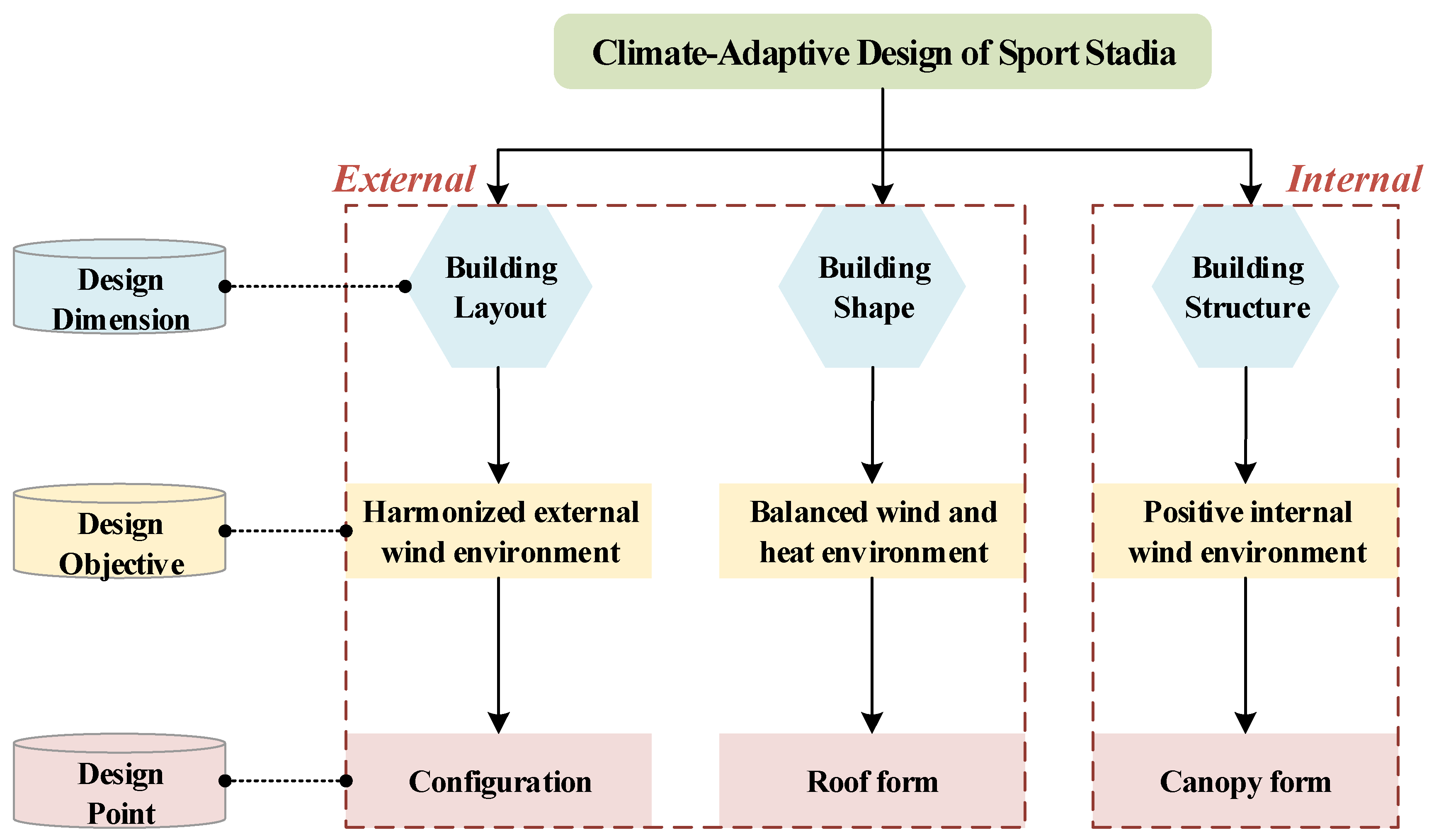
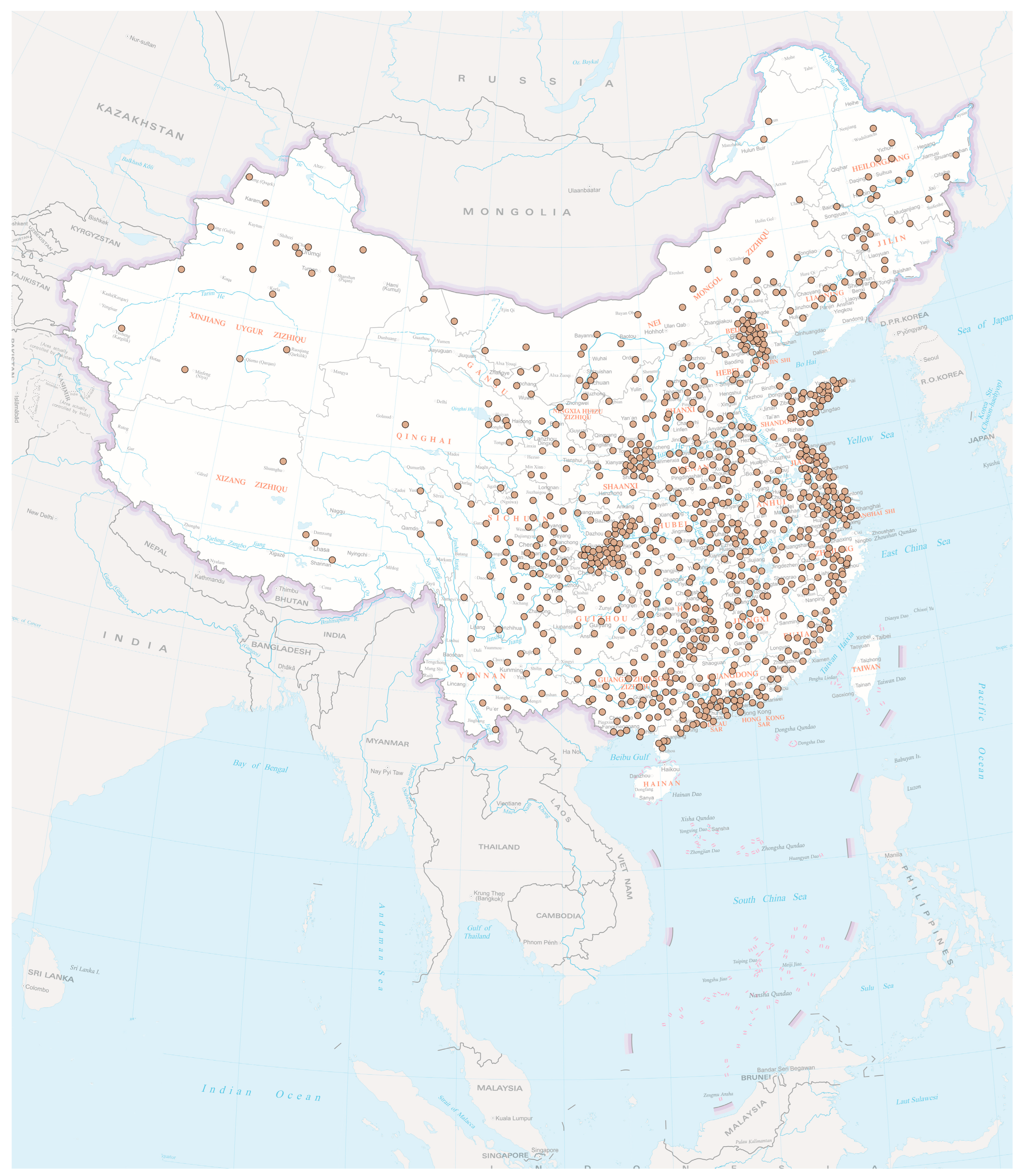
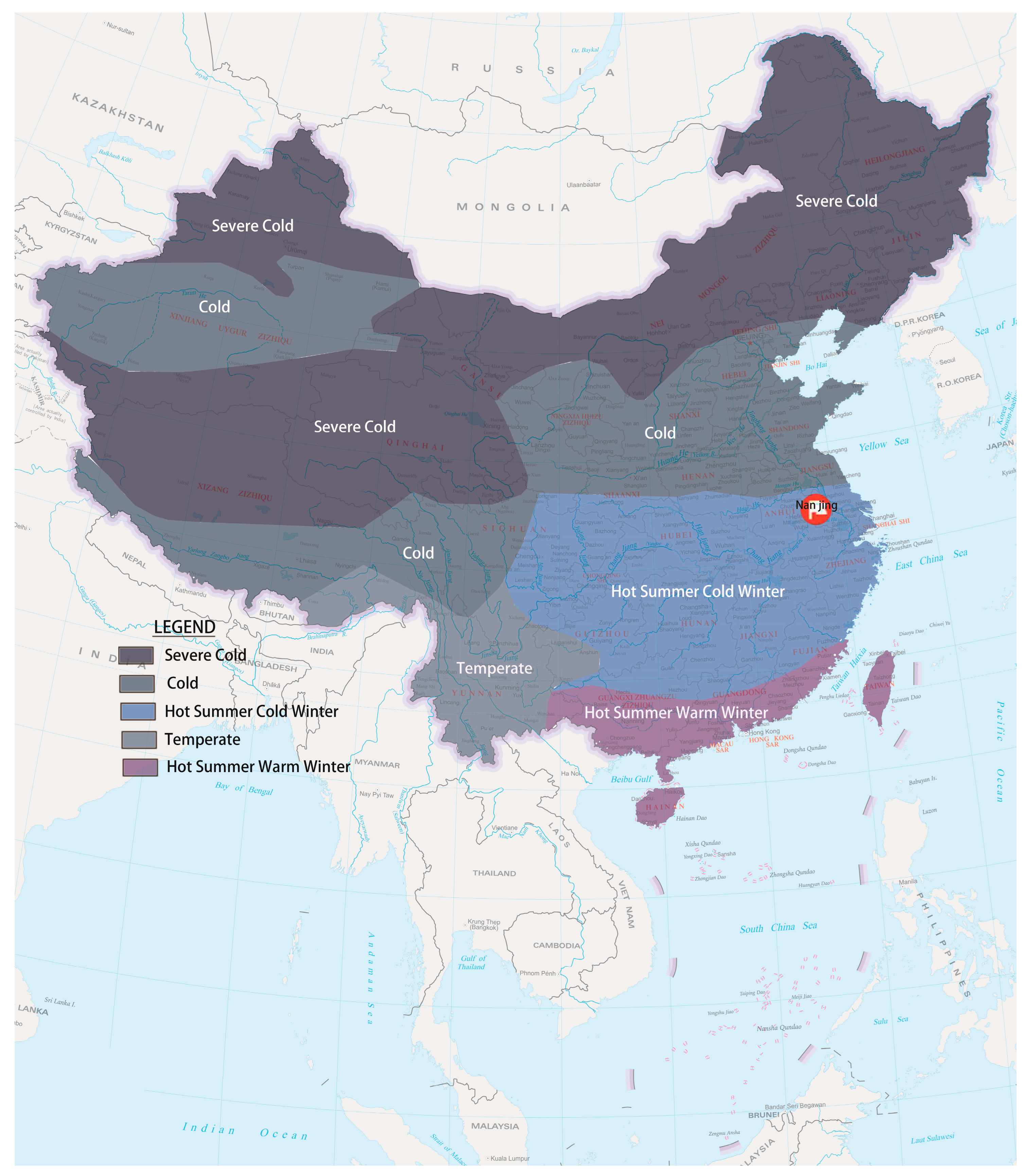

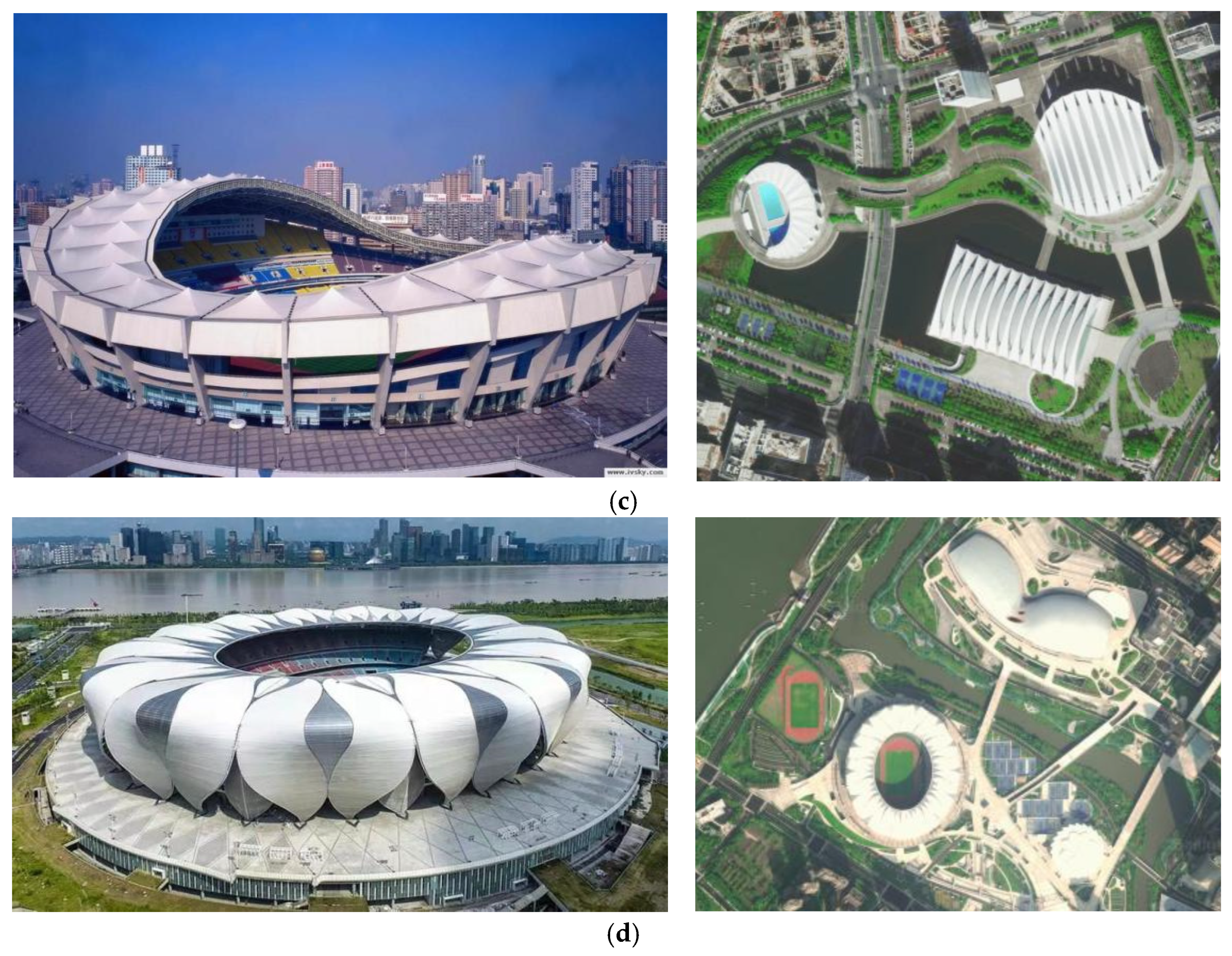

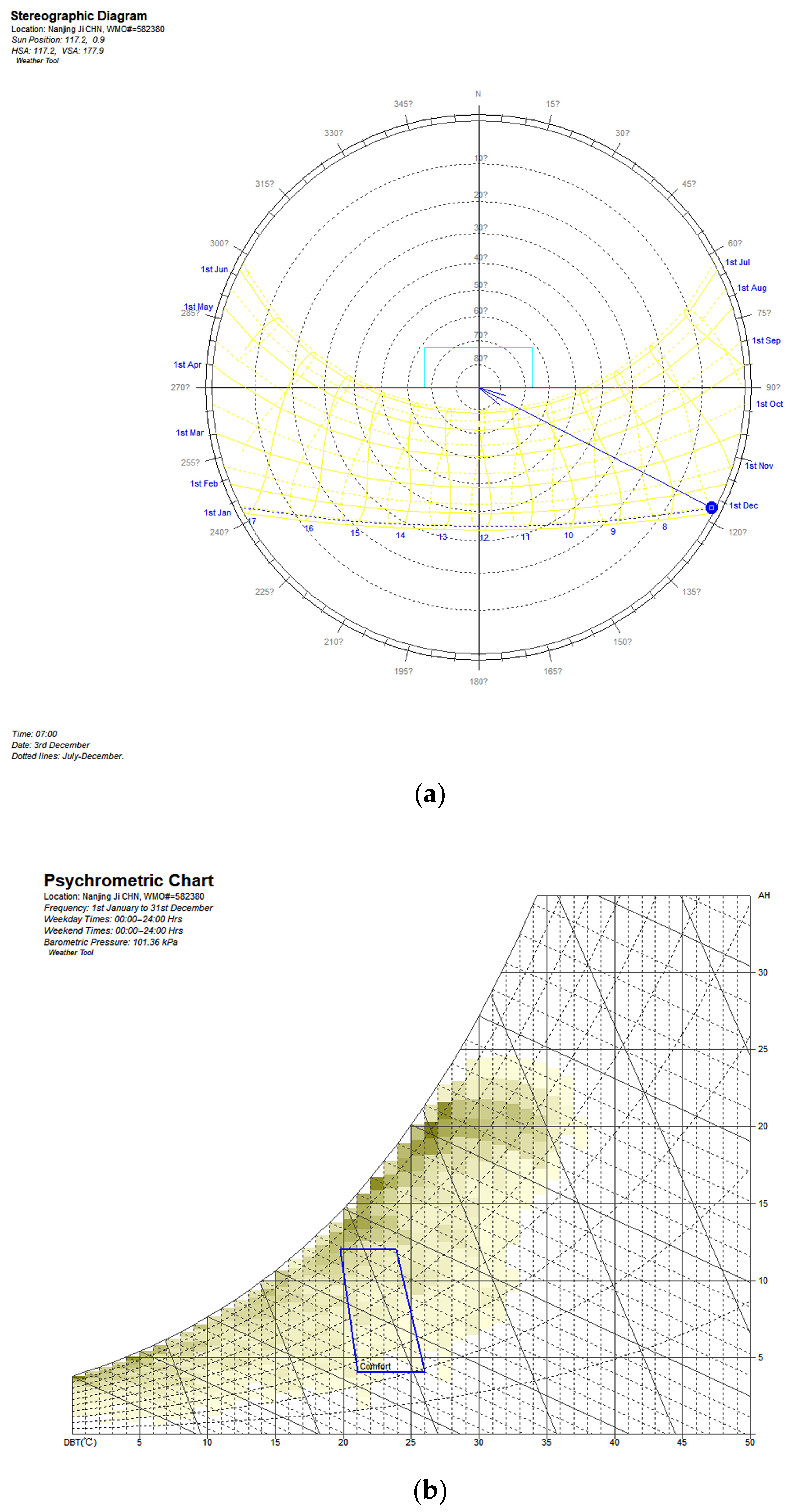
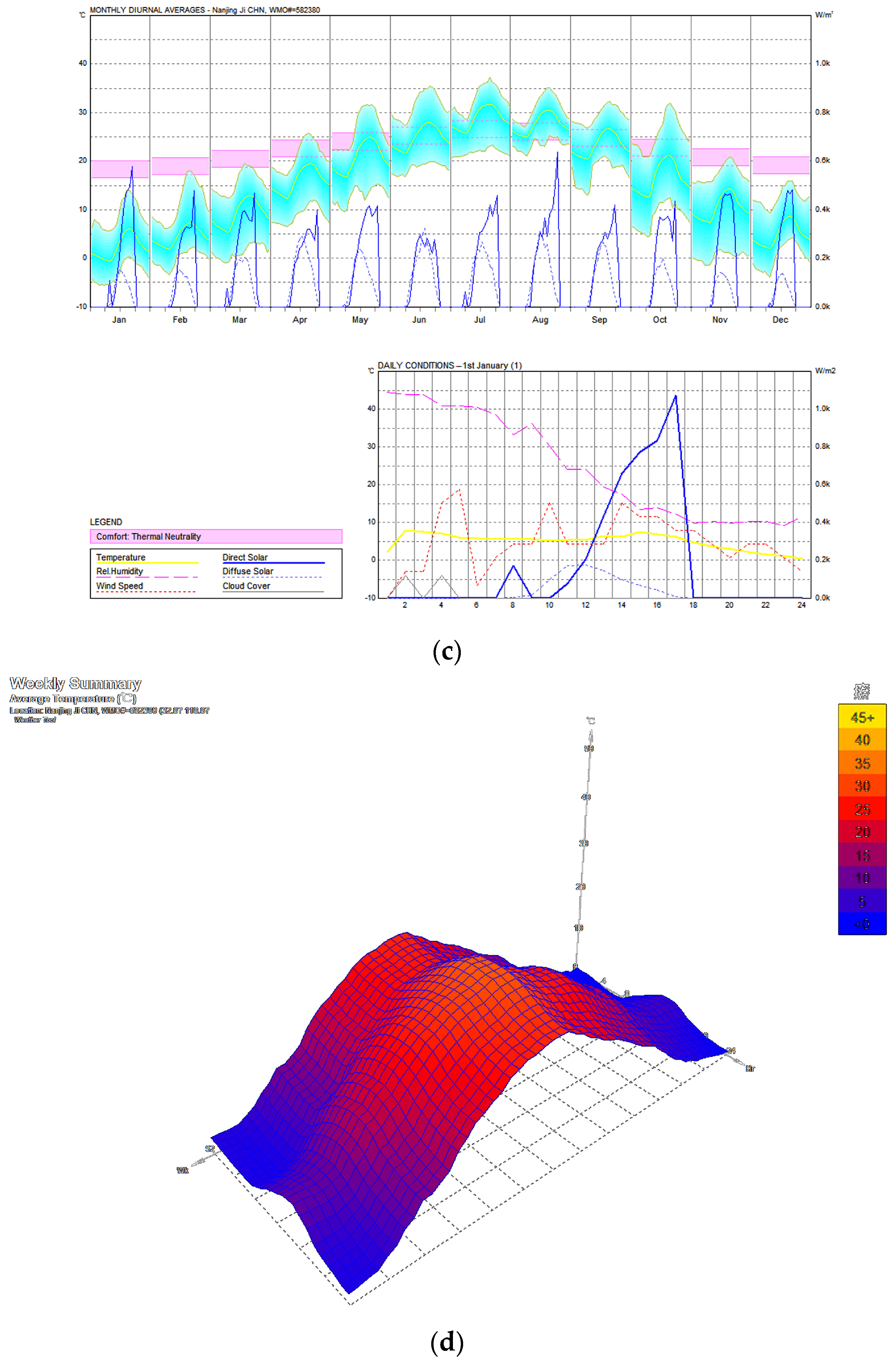

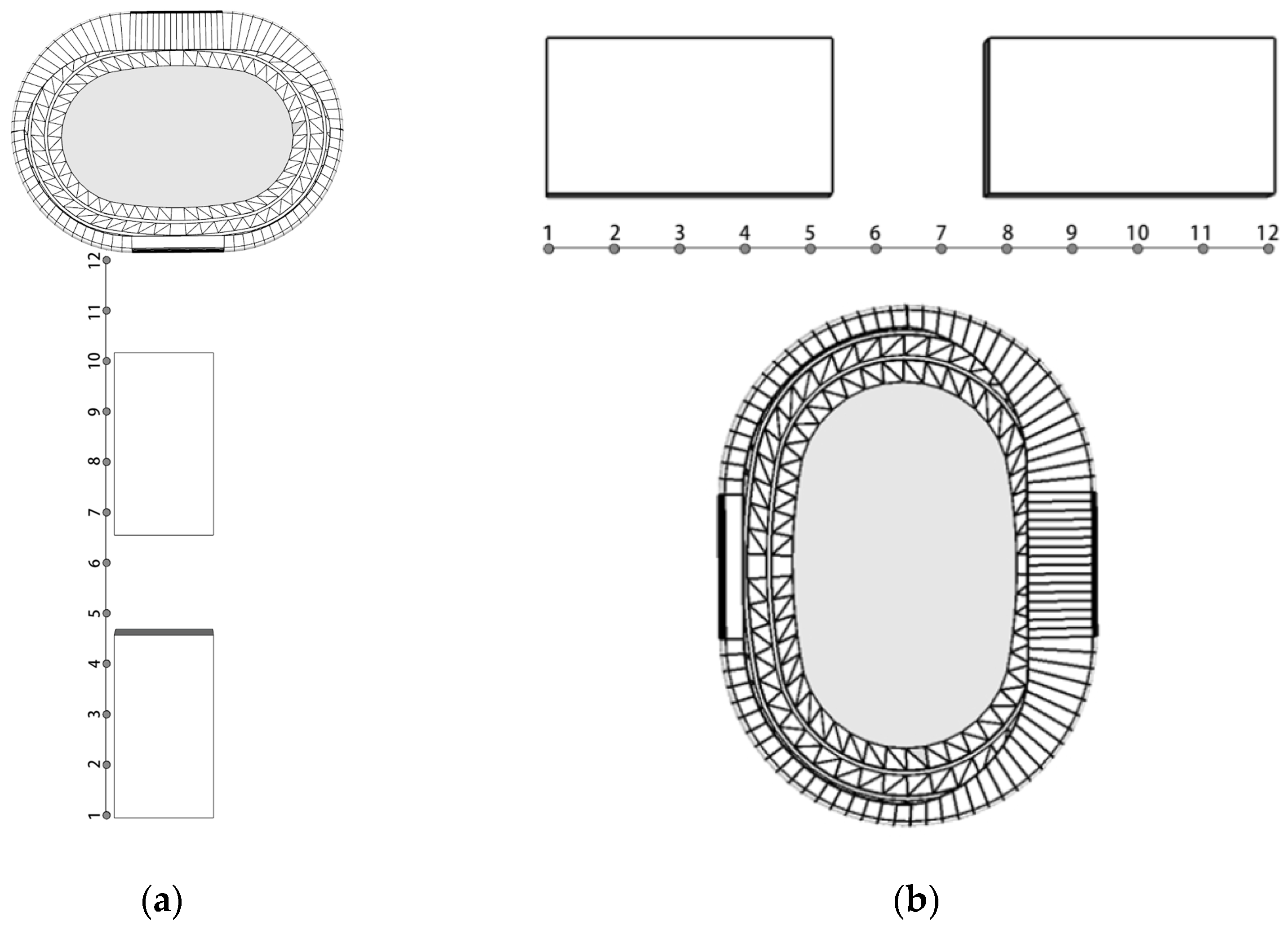
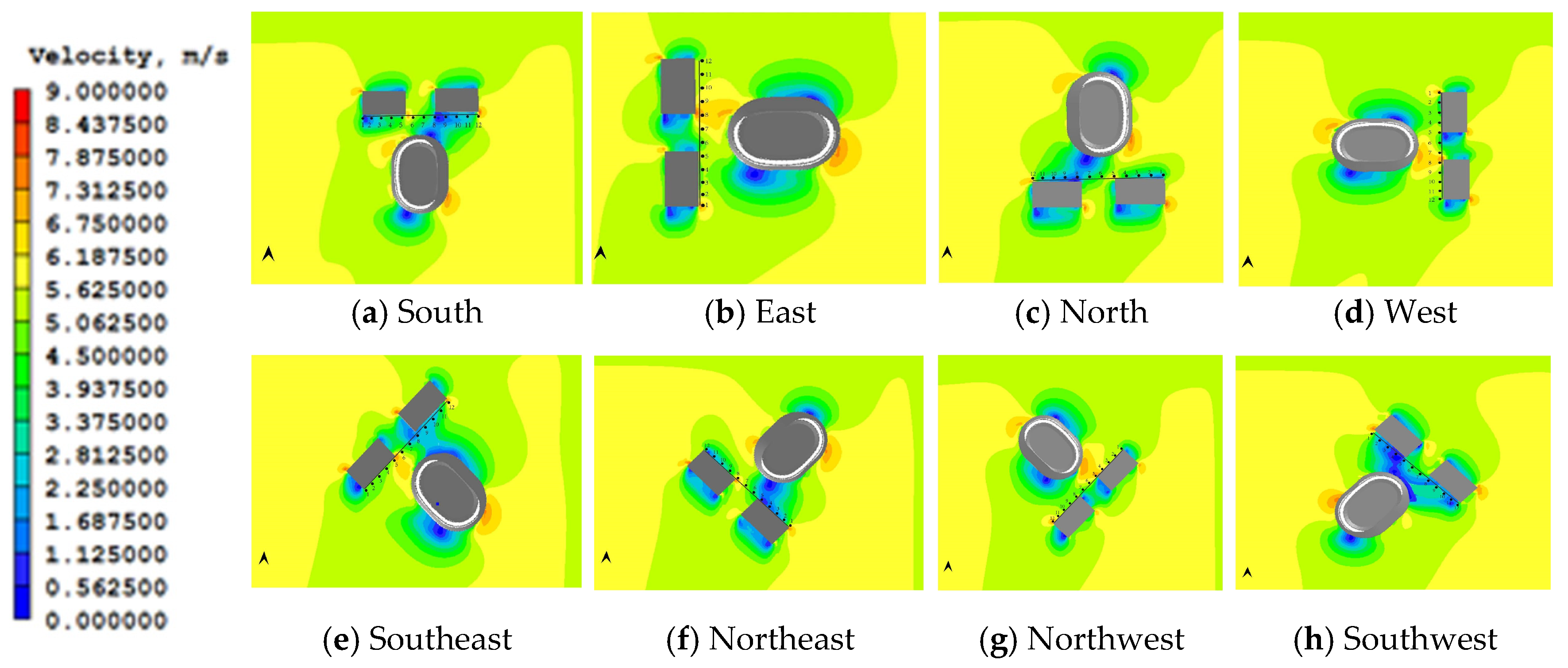
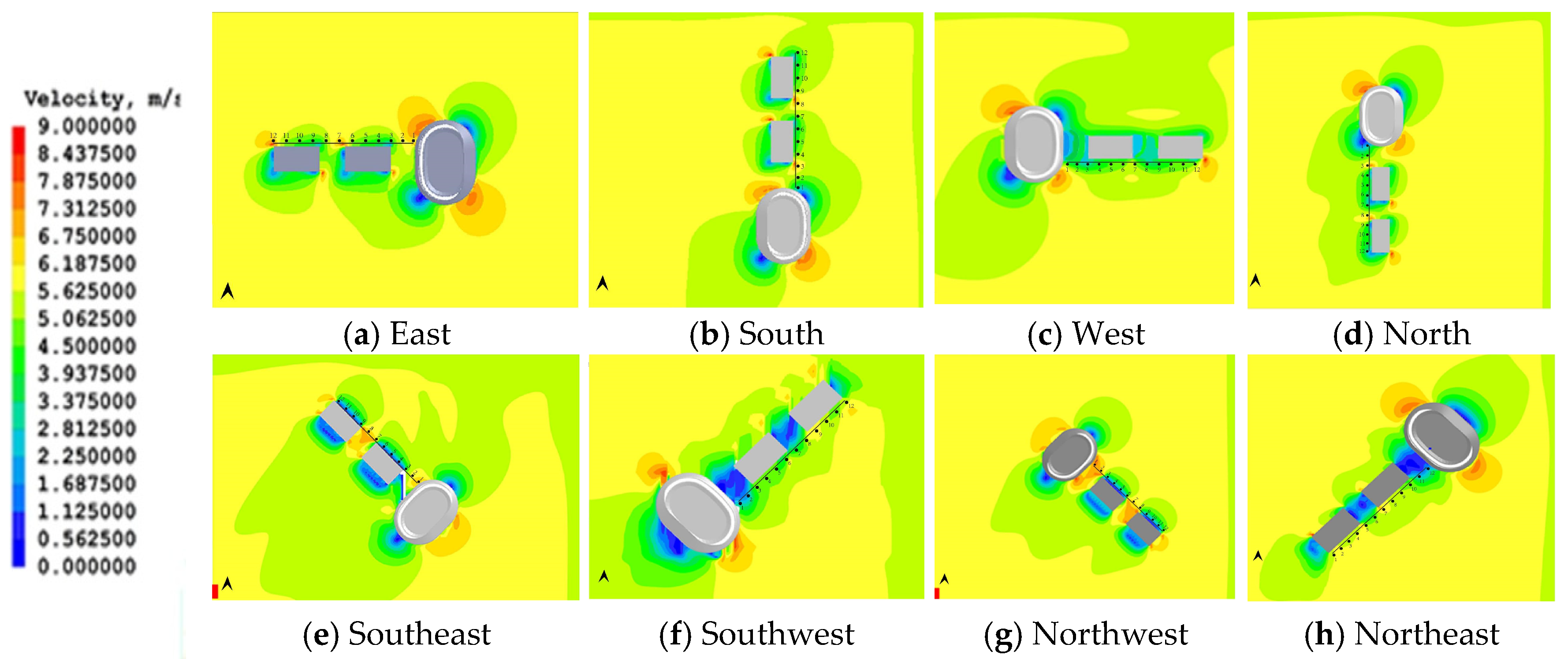
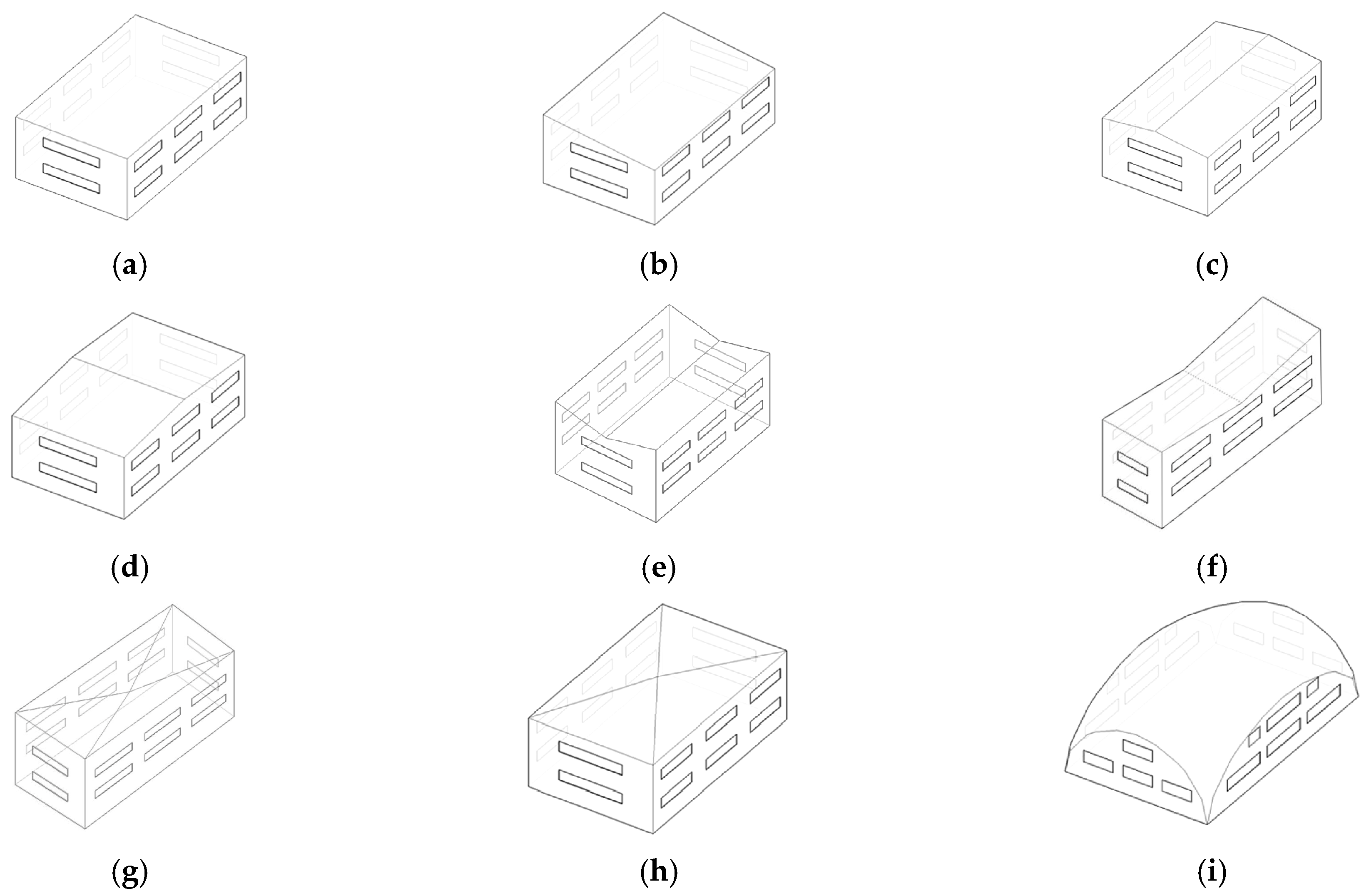
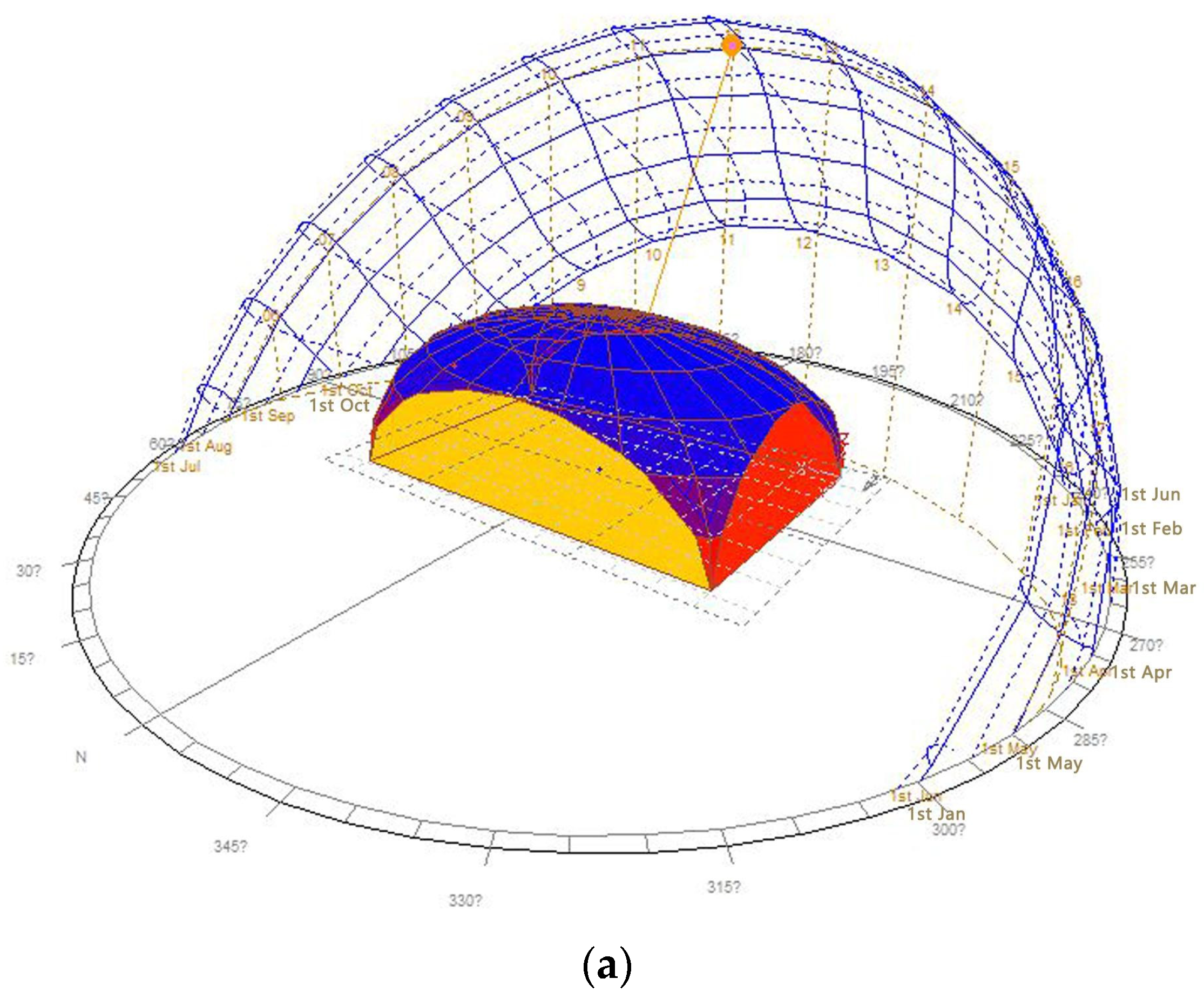
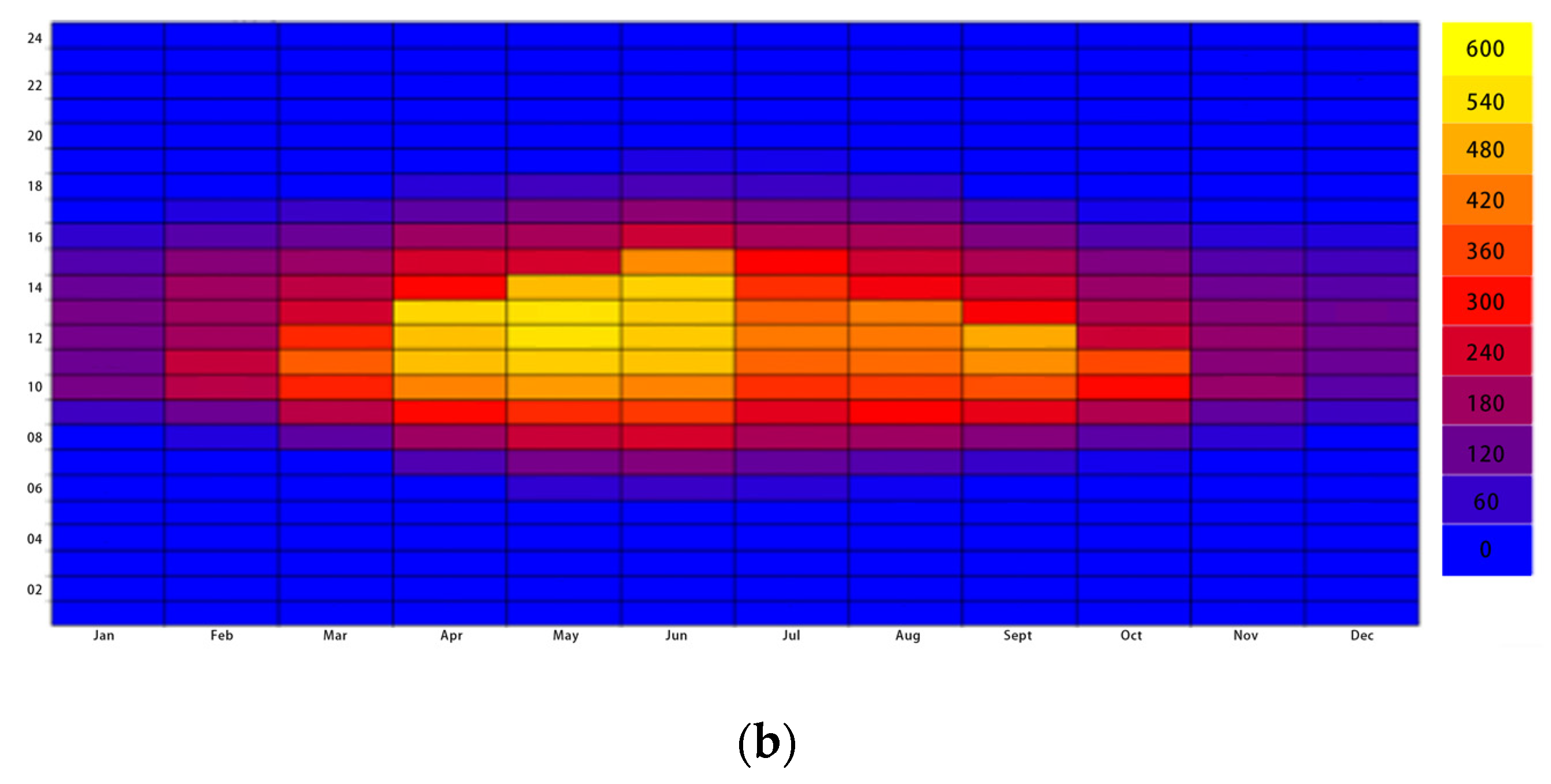


| Triangle | 1 | 2 | 3 | 4 | 5 | 6 | 7 | 8 | 9 | 10 | 11 | 12 | Mean |
|---|---|---|---|---|---|---|---|---|---|---|---|---|---|
| West | 1.1240 | 2.3026 | 3.3661 | 3.9591 | 6.1118 | 6.9458 | 4.1777 | 0.5960 | 1.0135 | 1.1755 | 1.0886 | 4.3785 | 3.0199 |
| North-west | 3.3597 | 3.4807 | 3.2984 | 3.2633 | 5.9160 | 4.6497 | 2.4513 | 0.0290 | 1.2746 | 1.2624 | 3.3347 | 7.3372 | 3.3047 |
| South-west | 6.4813 | 3.6839 | 3.1583 | 3.6070 | 3.1768 | 4.1301 | 6.8990 | 7.1124 | 6.2923 | 4.4333 | 4.3215 | 4.2796 | 4.7980 |
| East | 3.1531 | 2.2143 | 2.0123 | 1.9072 | 0.7247 | 4.0019 | 5.3377 | 6.5161 | 4.5740 | 4.4639 | 1.2511 | 0.8291 | 3.0821 |
| South | 2.1364 | 2.2169 | 2.0169 | 3.9117 | 6.1773 | 3.1606 | 2.1056 | 2.2995 | 2.1469 | 2.2165 | 2.7288 | 6.9369 | 3.1712 |
| North-east | 2.4357 | 3.4518 | 3.3858 | 6.0058 | 7.0543 | 4.9270 | 3.9398 | 3.9857 | 3.8140 | 3.8187 | 5.7679 | 7.4711 | 4.6715 |
| South-east | 6.1784 | 2.8213 | 3.2078 | 3.2245 | 4.0664 | 4.3949 | 5.0112 | 6.1106 | 4.4713 | 5.7440 | 5.2246 | 3.9264 | 4.5318 |
| North | 4.6896 | 0.8117 | 0.5561 | 0.1453 | 2.5813 | 3.1586 | 4.0602 | 1.7527 | 2.1475 | 1.9764 | 0.2658 | 0.6105 | 1.8963 |
| One-Line | 1 | 2 | 3 | 4 | 5 | 6 | 7 | 8 | 9 | 10 | 11 | 12 | Mean |
|---|---|---|---|---|---|---|---|---|---|---|---|---|---|
| West | 5.1336 | 4.4904 | 1.8738 | 2.0535 | 3.5404 | 4.6226 | 6.1842 | 3.1762 | 2.5093 | 2.1775 | 2.8553 | 7.2744 | 3.8243 |
| North-west | 2.3688 | 3.1397 | 1.8360 | 2.1574 | 2.1527 | 2.0383 | 1.6648 | 1.2617 | 2.2783 | 3.1833 | 1.0099 | 1.3089 | 2.0393 |
| South-west | 0.0841 | 3.6942 | 6.4835 | 2.7246 | 3.4653 | 2.3127 | 3.5129 | 6.5852 | 2.0103 | 1.5581 | 1.4178 | 1.5651 | 2.9511 |
| East | 0.1229 | 1.4414 | 5.5715 | 5.2004 | 4.3755 | 3.3247 | 3.7901 | 5.2892 | 5.9661 | 5.2646 | 3.0602 | 4.9990 | 4.0338 |
| South | 1.4221 | 2.2812 | 1.3613 | 2.3496 | 5.0230 | 5.2598 | 3.1831 | 2.3583 | 3.3252 | 3.9116 | 3.1572 | 3.3424 | 3.0812 |
| North-east | 6.9264 | 5.1715 | 2.2512 | 1.0136 | 1.0575 | 1.0888 | 5.2789 | 4.4423 | 1.1880 | 1.0440 | 1.1334 | 2.4343 | 2.5025 |
| South-east | 1.0559 | 2.6347 | 5.9798 | 3.2081 | 3.4736 | 2.6593 | 3.0876 | 5.8560 | 2.0369 | 3.4842 | 3.7081 | 1.7132 | 3.2414 |
| North | 3.1743 | 3.0250 | 3.1612 | 3.7297 | 3.8136 | 3.2218 | 7.1507 | 4.1784 | 4.5189 | 3.7767 | 1.4931 | 1.2749 | 3.5432 |
| Type | The Radiant Surface Area (m2) | Total Radiation Value (wh/m2) | Mean Radiation Value (wh/m2) |
|---|---|---|---|
| Flat slope | 7900 | 53,983,330.7 | 6833.333 |
| Single slope | 7918.678 | 47,542,246.08 | 6003.811 |
| Short-sided double slope | 7673.863 | 73,880,238.81 | 9627.516 |
| Long-sided double slope | 7733.105 | 75,141,923.97 | 9716.915 |
| Short-sided concave | 8237.863 | 136,742,413.3 | 16,599.258 |
| Long-sided concave | 8133.105 | 95,773,630.8 | 11,775.777 |
| Double-sided concave | 8758.484 | 116,453,232.4 | 13,296.049 |
| Double side double slope | 7453.484 | 89,399,211.34 | 11,994.285 |
| Dome | 2063.476 | 27,436,078.01 | 13,296.049 |
| Dimension | Type | Simulation Result | Cause | Strategy |
|---|---|---|---|---|
| Layout | One-line | When the axis is east west, the maximum wind speed of the site is 4.0338 m/s; when the axis is northeast and northwest, the wind speed of the site is the smallest and the induced wind effect is significantly lower than that of other directions. | Since the prevailing wind direction crosses the axis at 45° in summer, the wind speed is highest when the dominant wind direction runs diagonally through the site; the axis of the stadia runs parallel to the field and the walls of the gymnasiums block most of the wind. | Under the demand for induced wind, the orientation of the layout needs to cross the site axis with the prevailing wind direction at 45° to achieve the highest wind speed of the site. |
| Triangle | The wind speed in the field is the largest in the southwest orientation, about 4.7980 m/s; the second is the northeast orientation, with a wind speed of about 4.6715 m/s; the wind speed in the due north direction is the lowest at only 1.8963 m/s. | When the axis of the stadia intersects diagonally with the dominant wind direction, the wind can better penetrate the square space formed by the two gymnasiums; the average wind speed in the north direction is the smallest and, after analysis, it is found that this is due to the fact that the air inlets and outlets are blocked by the gymnasiums, so the wind speed is the smallest. | From the perspective of the demand for ventilation in the field, the wind environment of the oblique layout is better than the positive layout. Wind blowing through the sides of the square can maximize wind speed in the square space. At the same time, it is necessary to try to make the square space as little as possible on the windward side. | |
| Shape | Flat slope | Radiant surface area: 7900.00 m2. Radiant heat increment: 53,983,330.70 wh. | Because of the uniform solar radiation, the flat slope is not greatly affected by the orientation of the building. | Follow-up measures include reducing the body size factor and improving natural ventilation and |
| Single slope | Radiant surface area: 7918.678 m2. Radiant heat increment: 47,542,246.08 wh. | The orientation of the single slope has a critical effect on heat increment. | adjusting the orientation and shape of the building to achieve a good relationship between solar radiation and radiant heat increment, while also considering synergy with natural ventilation technology. | |
| Short-sided double slope | Radiant surface area: 7673.863 m2. Radiant heat increment: 73,880,238.81 wh | There is a positive correlation between the external surface area of the roof slope and the amount of solar radiation. | The change of the roof shape of the building itself is used to form an effective shading surface and create a suitable thermal environment for the interior and exterior space of the building. | |
| Long-sided double slope | Radiant surface area: 7733.105 m2. Radiant heat increment: 75,141,923.97 wh. | The surface area and orientation of the long slope determine the amount of solar radiation. | Adjust the orientation of the outer surface of the long slope, increase the effective shading surface, and effectively reduce solar radiation. | |
| Short-sided concave | Radiant surface area: 8237.863 m2. Radiant heat increment: 136,742,413.30 wh. | Because the short side is concave and the long side is completely exposed to solar radiation, the surface area exposed to solar radiation is larger than that of other roofs. At the same time, the concave part of the roof is easy to accumulate large energy and is not easy to volatilize. | Adjust the orientation of the building, reduce the solar radiation on the long side, rationally use the wind pressure above and below the roof, increase the wind pressure on the welcoming and leeward sides of the gymnasium, strengthen the power of natural ventilation, and accelerate the rapid dissipation of accumulated energy. | |
| Long-sided concave | Radiant surface area: 8133.105 m2. Radiant heat increment: 95,773,630.80 wh. | The concave part of the roof is easy to accumulate large energy and is not easy to evaporate. At the same time, the roof is concave, resulting in a larger surface area than other roofs. | The formation of area changes at different interfaces in the wind direction strengthens the power of natural ventilation, accelerates the rapid dissipation of the accumulated energy of the roof, and then aggravates the contrast between the wind pressure of the stadium and the leeward side. | |
| Double-sided concave | Radiant surface area: 8758.484 m2. Radiant heat increment: 116,453,232.40 wh. | Because there are two concave parts, it is easier to accumulate more energy than the single concave, it is not easy to volatilize, and the surface area of the double-concave building is also larger. | On the basis of the area change of different interfaces in the wind direction, measures such as reducing the body size coefficient, reducing the total daily average solar radiation of the building, and effectively reducing the external surface area of external heat radiation can be taken. | |
| Double side double slope | Radiant surface area: 7453.484 m2. Radiant heat increment: 89,399,211.34 wh. | All four slopes are likely to have a positive correlation with the amount of solar radiation as a whole. | A more desirable body size factor of a building can be studied to form an effective shading surface and an external surface area that reduces heat source radiation. | |
| Dome | Radiant surface area: 2063.476 m2. Radiant heat increment: 27,436,078.01 wh. | Because the dome is a spherical curved surface, the heating surface area is smaller and the dome has the lowest radiant heat increment, so the dome has a significantly better ability to reduce radiant heat increment than other roof forms. | Shading components can be added to block the direct radiation of sunlight to the building interface and improve natural ventilation and other follow-up measures. | |
| Structure | Upward canopy | The wind speed stability is not good and the speed reduction is poor. | Whirlpools are formed in the northeast and southwest areas, the average wind speed in the audience area on the west side is significantly higher than that on the east side, and a small area of vortex circles appear locally on the northeast side. The static wind area is actively small, the wind speed difference inside and outside the field is not obvious, and the speed reduction is poor. | Pay attention to the upward tilt angle of the upward canopy, as a roof with too high an upward tilt angle will cause external airflow to pass above the site and prevent access to the interior space. |
| Flat canopy | The wind speed stability is good and the speed reduction is moderate. | The average wind speed in the sports area is the smallest under the three canopy profiles; there are many areas with sudden wind speed changes in the entire audience area, such as when the wind speed at the entrance is 15 m/s, the wind speed difference is about 7 m/s, and the area with multiple sudden wind speed changes only appears in the audience area. | Reasonable setting of openings in the grandstand area can make the wind environment in the field more uniform and, when selecting unilateral openings, it should be set on the inlet side. When setting up bilateral openings, try to stagger the settings to avoid alignment. | |
| Downward canopy | The wind speed reduction is the best, but the stability is poor. | The average wind speed inside the field is large and a large area of low wind speed circle appears locally on the southeast side. The area of static wind is small, the wind speed difference between inside and outside the field is obvious, and the speed reduction is the best. | Try to keep a gap height of more than 3 m between the canopy and the stand so that the stability of the wind environment in the field can be improved. |
Disclaimer/Publisher’s Note: The statements, opinions and data contained in all publications are solely those of the individual author(s) and contributor(s) and not of MDPI and/or the editor(s). MDPI and/or the editor(s) disclaim responsibility for any injury to people or property resulting from any ideas, methods, instructions or products referred to in the content. |
© 2023 by the authors. Licensee MDPI, Basel, Switzerland. This article is an open access article distributed under the terms and conditions of the Creative Commons Attribution (CC BY) license (https://creativecommons.org/licenses/by/4.0/).
Share and Cite
Xiong, D.; Cheng, K.; Chen, J. Climate-Adaptive Design Strategies of Sports Stadia in a Hot Summer and Cold Winter Zone: A Case Study of Nanjing. Buildings 2023, 13, 2238. https://doi.org/10.3390/buildings13092238
Xiong D, Cheng K, Chen J. Climate-Adaptive Design Strategies of Sports Stadia in a Hot Summer and Cold Winter Zone: A Case Study of Nanjing. Buildings. 2023; 13(9):2238. https://doi.org/10.3390/buildings13092238
Chicago/Turabian StyleXiong, Dongxu, Kai Cheng, and Jingjing Chen. 2023. "Climate-Adaptive Design Strategies of Sports Stadia in a Hot Summer and Cold Winter Zone: A Case Study of Nanjing" Buildings 13, no. 9: 2238. https://doi.org/10.3390/buildings13092238
APA StyleXiong, D., Cheng, K., & Chen, J. (2023). Climate-Adaptive Design Strategies of Sports Stadia in a Hot Summer and Cold Winter Zone: A Case Study of Nanjing. Buildings, 13(9), 2238. https://doi.org/10.3390/buildings13092238









